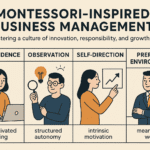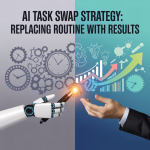
The Montessori Method in the Modern Workplace: Cultivating Success Through Respect, Environment, Observation, and Self-Directed Learning
In an era of rapid innovation and a constant quest for a more engaged and productive workforce, businesses are increasingly looking to unconventional models for inspiration.
One such philosophy, born from early 20th-century classrooms, is proving to be a remarkably effective blueprint for modern business success: the Montessori method.
Developed by Dr. Maria Montessori, this educational approach is grounded in core principles that, when translated to the corporate world, can foster a culture of innovation, employee satisfaction, and sustainable growth.
The key tenets of respect for the individual, a prepared environment, keen observation, and self-directed learning offer a powerful framework for leaders aiming to unlock the full potential of their teams.
Respect for the Individual: The Foundation of Empowerment
At the heart of the Montessori philosophy lies a profound respect for the individual, a belief that each person, whether a child in a classroom or an employee in a company, possesses a natural drive to learn, contribute, and take pride in their work.
In a business context, this translates to a culture of trust and empowerment.
Just as Montessori students are entrusted with managing their own tasks and learning paths, employees thrive when they are given the autonomy to take ownership of their responsibilities.
This principle is a stark contrast to traditional top-down management styles, which can stifle creativity and disengage employees.
When individuals are micromanaged, their potential is limited to the vision of their superiors.
Conversely, when they are trusted to navigate their own projects and make decisions, they are more likely to be invested in the outcomes, leading to higher quality work and a greater sense of purpose.
This approach is exemplified by the often-cited “20% Time” at Google, a policy that allowed employees to spend a fifth of their workweek on projects of their own choosing.
This freedom to explore and experiment, rooted in a fundamental respect for the individual’s curiosity and capabilities, famously led to the creation of some of Google’s most successful products, including Gmail and AdSense.
While the policy has evolved, its legacy underscores the power of trusting employees to be the architects of their own contributions.
Similarly, Netflix’s culture of “freedom and responsibility” empowers employees with significant autonomy, operating on the belief that responsible people thrive on freedom and are worthy of it.
The Prepared Environment: Designing for productivity and Well-being
A cornerstone of the Montessori method is the “prepared environment” – a space meticulously designed to be orderly, accessible, and conducive to learning.
In the business world, this concept extends beyond physical office design to encompass the entire organizational culture and digital workspace.
A well-prepared business environment is one that is structured for success, yet flexible enough to adapt to the evolving needs of its employees.
This includes providing the necessary tools and resources for a seamless workflow, creating clear and efficient communication channels, and fostering a psychologically safe atmosphere where collaboration and innovation can flourish.
The physical layout of an office can play a significant role, with a variety of spaces that cater to different work styles – from quiet zones for focused tasks to collaborative hubs for brainstorming sessions.
However, the “prepared environment” in a modern business is also digital.
This means intuitive and well-organized digital filing systems, accessible project management tools, and streamlined communication platforms that reduce friction and frustration.
A cluttered and chaotic digital workspace can be just as detrimental to productivity as a messy physical one.
The French gearbox manufacturer, FAVI, offers a compelling real-world example of a prepared environment in a manufacturing setting.
By organizing its factory into autonomous, client-focused teams, FAVI created a system where employees have everything they need to self-manage, from production planning to client communication.
This structure has been credited with the company’s remarkable success and longevity in a competitive European market.
Observation: The Leader’s Most Powerful Tool
In a Montessori classroom, the teacher is not a lecturer but a guide, and their primary tool is observation.
By carefully and non-judgmentally observing students, they can understand their individual needs, interests, and challenges, and provide support and resources accordingly.
This principle of observational leadership is equally transformative in a business setting.
Leaders who practice observation gain a much deeper and more accurate understanding of their team’s dynamics, workflows, and potential roadblocks.
Instead of relying on assumptions or infrequent progress reports, they can make informed decisions based on real-time insights.
This can involve paying attention to communication patterns, identifying areas of friction in processes, and recognizing the unique strengths and working styles of each team member.
Observational leadership is not about surveillance; it is about being present and perceptive.
It allows leaders to move beyond a one-size-fits-all management approach and tailor their guidance to the specific needs of individuals and the team as a whole.
This can lead to more effective problem-solving, improved team cohesion, and a more responsive and agile organization.
Self-Directed Learning: Fueling Innovation and Job Satisfaction
The Montessori approach champions the idea that true learning is self-directed and driven by intrinsic motivation.
When individuals are encouraged to pursue their own interests and take ownership of their development, they are more likely to be engaged, innovative, and deeply satisfied with their work.
In a corporate setting, fostering a culture of self-directed learning means providing employees with the opportunities and resources to grow their skills and knowledge in ways that are meaningful to them.
This can take many forms, from offering a budget for professional development courses and conferences to creating internal mentorship programs and knowledge-sharing platforms.
The benefits of this approach are twofold. For the employee, it leads to a sense of mastery and continuous growth, which are powerful drivers of job satisfaction and loyalty.
For the organization, it cultivates a workforce that is adaptable, forward-thinking, and capable of driving innovation from the ground up.
The success of many of today’s leading companies is a testament to the power of their founders’ own self-directed learning, a trait many, including the founders of Amazon and Wikipedia, attribute to their Montessori educations.
In conclusion, the principles that have guided young learners for over a century offer a timeless and increasingly relevant framework for business success.
By cultivating an environment of respect and trust, preparing the workspace for productivity and well-being, leading with keen observation, and empowering employees to direct their own growth, organizations can unlock a new level of engagement, innovation, and ultimately, a more human and effective way of working.
The Montessori method, it seems, is not just for children; it is a powerful philosophy for building the businesses of the future.
Go to Montessori Business Main












 productivity
productivity


